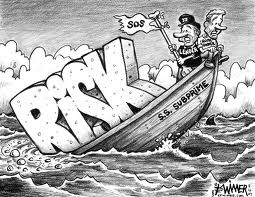Reprogramming That Recession—& The Next One
“Make no mistake about it. The banks are still in trouble. The proverbial unadvertised “dirty little secret” is that they continue to hold hundreds of billions of dollars in first and especially second mortgages on balance sheets at phony historical-cost values. The failure to revalue these assets and the glacial pace of realistic re-mortgaging continue to oppress the economy and circumscribe its growth.” Sanford Rose
Dolors & Sense
by Sanford Rose
KISSIMMEE Florida—(Weekly Hubris)—7/30/2012—Let’s rewind. It’s the early fall of 2008. Mortgages are tobogganing. Banks are shaking because the public now perceives that their capital, dependent on the book value of these mortgages is, in reality, non-existent. The Executive Branch asks Congress for emergency aid.
Now we edit the tape. The Congress, experiencing an epiphany of unknown origin, says: “Hold on, Mr. Secretary of the Treasury, you don’t need money. You need just to flex your regulatory muscle, and that of the Fed Chairman and the Federal Deposit Insurance Corp., and much of this problem will evaporate.
“After all, quantum mechanics teaches us that reality is an illusion. Now let’s make an illusion reality.
“Let us substitute for the capital banks say they have, but really don’t have, capital that the governmental regulatory agencies say they have, but they still don’t have.
“More specifically, you regulators will require banks to mark down the principal value of their mortgage assets according to the property depreciation prevailing in given local areas and proceed to re-mortgage at those reduced values to home owners.
“This will lead to the decline in bank capital values that a more honest system of loan accounting would already have revealed. To offset this decline, you will re-introduce the net-worth-certificate program.”
Of course, the wise heads of the regulatory bodies would have remembered that the net worth certificate was a repayable form of temporary, interest-bearing equity inserted by the FDIC onto savings-bank balance sheets in the post-1982 period. Essentially, the FDIC created a simultaneous “ersatz” increase in bank net-worth liabilities and corresponding assets at no cost to the public.
The ploy worked to a certain extent: the market in the 1980s acted as if these banks had actually acquired more capital.
It might have worked again in 2008.
Banks would have suddenly become solvent. Relieved of the overhang of unrealized asset depreciation, they would have become more amenable to lending.
Relieved of the overhang of inflated mortgage debt, consumers would have become more amenable to spending. They would certainly have become less prone to mortgage default, thereby blunting somewhat the prospective further fall in house prices.
The recession would have been milder, much milder.
This is not an arid “what-if” exercise.
Make no mistake about it. The banks are still in trouble.
The proverbial unadvertised “dirty little secret” is that they continue to hold hundreds of billions of dollars in first and especially second mortgages on balance sheets at phony historical-cost values.
The failure to revalue these assets and the glacial pace of realistic re-mortgaging continue to oppress the economy and circumscribe its growth.
Perhaps a belated regulatory epiphany would still be appropriate.
Perhaps it’s time for a regulatory ukase that offers the bargain needed but not made in 2008: “We will re-capitalize, at no public dollar outlay, if you will re-mortgage.”



2 Comments
Richard Gregory
Thank you for the insightful post. As a graduate student, I published research on the FDIC program and how it benefited banks. Why the lessons of the S&L bailout were ignored in the current crises is understandable: the banks hated the S&L bailout because of the legislation, notably, FDICIA, which it produced , that gave regulators more power to close troubled banks. Or at least, that’s how they remember it, though exactly how it gave the government more power over them is an open question.
srose
To Richard:
The renewal of a certificate program would have been viewed as an enormous subsidy to banks, giving them capital at a cost much less than their risk-adjusted cost (CAPM). So I do not think that the politicians seriously contemplated it. Of course, they ended up subsidizing banks to a far greater extent through TARP and the Fed’s zero-interest funds rate.
That is normal in a crisis of increasing severity, the dimensions of which are not adequately foreseen.
Best
SRose